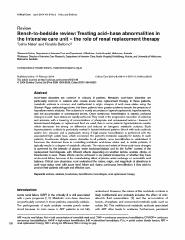Please use this identifier to cite or link to this item:
https://ahro.austin.org.au/austinjspui/handle/1/9714| Title: | Bench-to-bedside review: treating acid-base abnormalities in the intensive care unit--the role of renal replacement therapy. | Austin Authors: | Naka, Toshio;Bellomo, Rinaldo | Affiliation: | Department of Intensive Care, Austin Hospital, Heidelberg, Victoria, Australia | Issue Date: | 17-Feb-2004 | Publication information: | Critical Care 2004; 8(2): 108-14 | Abstract: | Acid-base disorders are common in critically ill patients. Metabolic acid-base disorders are particularly common in patients who require acute renal replacement therapy. In these patients, metabolic acidosis is common and multifactorial in origin. Analysis of acid-base status using the Stewart-Figge methodology shows that these patients have greater acidemia despite the presence of hypoalbuminemic alkalosis. This acidemia is mostly secondary to hyperphosphatemia, hyperlactatemia, and the accumulation of unmeasured anions. Once continuous hemofiltration is started, profound changes in acid-base status are rapidly achieved. They result in the progressive resolution of acidemia and acidosis, with a lowering of concentrations of phosphate and unmeasured anions. However, if lactate-based dialysate or replacement fluid are used, then in some patients hyperlactatemia results, which decreases the strong ion difference and induces an iatrogenic metabolic acidosis. Such hyperlactatemic acidosis is particularly marked in lactate-intolerant patients (shock with lactic acidosis and/or liver disease) and is particularly strong if high-volume hemofiltration is performed with the associated high lactate load, which overcomes the patient's metabolic capacity for lactate. In such patients, bicarbonate dialysis seems desirable. In all patients, once hemofiltration is established, it becomes the dominant force in controlling metabolic acid-base status and, in stable patients, it typically results in a degree of metabolic alkalosis. The nature and extent of these acid-base changes is governed by the intensity of plasma water exchange/dialysis and by the 'buffer' content of the replacement fluid/dialysate, with different effects depending on whether lactate, acetate, citrate, or bicarbonate is used. These effects can be achieved in any patient irrespective of whether they have acute renal failure, because of the overwhelming effect of plasma water exchange on nonvolatile acid balance. Critical care physicians must understand the nature, origin, and magnitude of alterations in acid-base status seen with acute renal failure and during continuous hemofiltration if they wish to provide their patients with safe and effective care. | Gov't Doc #: | 15025771 | URI: | https://ahro.austin.org.au/austinjspui/handle/1/9714 | DOI: | 10.1186/cc2821 | Journal: | Critical Care | URL: | https://pubmed.ncbi.nlm.nih.gov/15025771 | Type: | Journal Article | Subjects: | Acetates Acid-Base Imbalance.diagnosis.physiopathology.therapy Bicarbonates Critical Care.methods Critical Illness.therapy Hemofiltration Humans Intensive Care Units Lactates Renal Replacement Therapy |
| Appears in Collections: | Journal articles |
Files in This Item:
| File | Description | Size | Format | |
|---|---|---|---|---|
| 15025771.pdf | 942.06 kB | Adobe PDF |  View/Open |
Page view(s)
42
checked on Jan 4, 2025
Download(s)
112
checked on Jan 4, 2025
Google ScholarTM
Check
Items in AHRO are protected by copyright, with all rights reserved, unless otherwise indicated.
